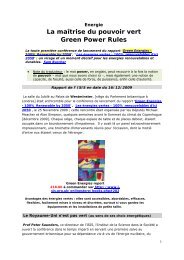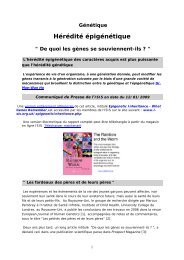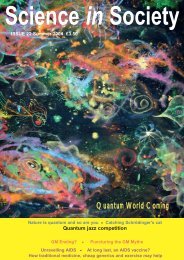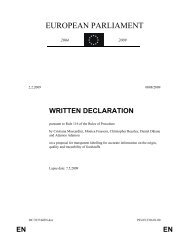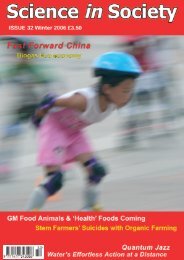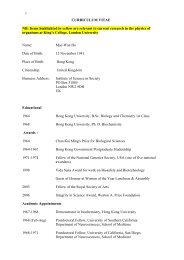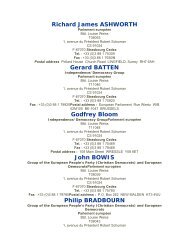Preview - The Institute of Science In Society
Preview - The Institute of Science In Society
Preview - The Institute of Science In Society
Create successful ePaper yourself
Turn your PDF publications into a flip-book with our unique Google optimized e-Paper software.
88Jade Ho was born in Minneapolis, Minnesota, and became a passionate painter at the age <strong>of</strong> two, revealing an unusual sensefor colour and style that extends to her daily dress. Her paintings have attracted the devoted following <strong>of</strong> parents and grandparentsand appeared in <strong>Science</strong> in <strong>Society</strong>, and the cover <strong>of</strong> the important Green Energies report. She attends KenwoodElementary School, likes singing, plays the piano, and is a blue belt in Kungfu.Jasmine Ho was born in Los Angeles, California, and now lives in Minneapolis, Minnesota, with her mother, father, youngersister and fellow artist Jade, and her pet dog and cat. She attended Kenwood Elementary School, South View Middle School,and is in her sophomore year in Edina High School, where she is involved in a school leadership group, a cultural awarenessgroup, and the debate club.Jasmine started painting and drawing when she was three years old, when her favourite subject was gardens andraindrops. <strong>The</strong>y have been featured in many issues <strong>of</strong> <strong>Science</strong> in <strong>Society</strong>, including the cover <strong>of</strong> two issues. Jasmine’s currentinterests include soccer, track and field (running), reading, ceramics, and sketching. She does not have a specific career inmind, but does plan on pursuing a college education.Mae-Wan Ho, B.Sc. (First Class) and Ph. D. Biochemistry, Hong Kong University, is best known for pioneering work on thephysics <strong>of</strong> organisms and sustainable systems; also a critic <strong>of</strong> genetic engineering biotechnology and neo-Darwinism. Sheis Director and co-founder <strong>of</strong> the <strong><strong>In</strong>stitute</strong> <strong>of</strong> <strong>Science</strong> in <strong>Society</strong>, and Editor-in-Chief and Art Director <strong>of</strong> its trend-settingquarterly magazine <strong>Science</strong> in <strong>Society</strong>. She has received several awards and recognition for promoting scientific integrity andaccountability.Regarded by some as “the most influential scientist alive today,” her work not only informs the public and policy-makers,but is also appreciated by other scientists as well as those trained in arts and the humanities, being herself an occasionalartist and poet. Mae-Wan advises national government as well as United Nations agencies on a range <strong>of</strong> issues from geneticmodification to sustainable agriculture and renewables energies, and was even asked by the late Malcolm McClaren to be hisscientific adviser when he briefly considered running for the Major <strong>of</strong> London.She is much in demand as a public speaker, and continues to contribute to scientific research since retiring from academiain 2000. She has more than 170 scientific publications and over 500 popular articles in the most diverse fields across allscientific disciplines. Her books include Beyond neoDarwinism: An <strong>In</strong>troduction to the New Evolutionary Paradigm (1984);Evolutionary Processes and Metaphors (1988); <strong>The</strong> Rainbow and the Worm, the Physics <strong>of</strong> Organisms (1993, 2nd ed.1998,reprinted 1999, 2001, 2003, 2005; 2006, 3rd ed, 2008); Bioelectrodynamics and Biocommunication (1994), Bioenergetics(1995); Genetic Engineering Dream or Nightmare? (1998, 1999, reprint with extended introduction, 2007); Living with theFluid Genome (2003); <strong>The</strong> Case for a GM-Free Sustainable World (2003, 2004); Unravelling AIDS (2005); Which Energy?(2006); Food Futures Now (2008); Green Energies, 100% Renewables by 2050 (2009).Michel Kappeli was raised in an urban environment. After art school in Switzerland and years <strong>of</strong> travel, he stayed in a remoteplace in Finland, where his fascination for transformation in nature became the focus <strong>of</strong> his artistic concepts. His first-prizewinningproject in a national art-on-building competition featured the environment in the structure <strong>of</strong> the building.Back in Switzerland, he infused the urban with structures <strong>of</strong> nature. With materials such as silicone and PVC, he built organicstructures. Even for printing, by tradition an extremely exact way to create replicas, he created s<strong>of</strong>t printing blocks <strong>of</strong> siliconeto achieve different results from print to print.Time as a guide-line for transformation appeared in his first works <strong>of</strong> manipulated urban sounds. <strong>The</strong> original sound<strong>of</strong> a scene was gradually decelerated; the perceiver led from a known environment to a transformed circumstance, where thenow slowed, alienated sounds were received as intensified images created by ones’ own memory.At the exhibition in a neo-Gothic church, organized by the famous gallery owner Diego Stampa, the Director <strong>of</strong> theBasle Art Hall Peter Pakesch and the priest Felix Felix, the concept <strong>of</strong> transformation <strong>of</strong> Michel Kappeli’s former soundscapeswas adapted to a corridor <strong>of</strong> twelve three-dimensional 17-foot tall pictures made <strong>of</strong> sculpted heavy plastic sheets. Startingfrom a human figure, the development from one image to the next, led from a surface zoomed more and more into detail,until it reached the structure <strong>of</strong> a microscopic world.What was divided into sequences <strong>of</strong> evolution in his sculptural “paintings” was later compressed to layers <strong>of</strong> paintedtransparency film, and combined into single three-dimensional pictures.<strong>The</strong> different conditions <strong>of</strong> presence found a new intensity in his light performances, which he painted with a colouredtorchlight in a darkened room. <strong>The</strong> sound <strong>of</strong> a decelerated everyday scene was the guide-line for the evolution <strong>of</strong> theimage. <strong>The</strong> sum <strong>of</strong> all the movements <strong>of</strong> light was captured on the film <strong>of</strong> a camera with a constantly open shutter. <strong>The</strong> finalimage captured by another camera on Polaroid was then shown to the public.<strong>The</strong> experiments with light and sound led also to performative sculpting and combinations <strong>of</strong> words and pictorialmetaphor.What were artistic concepts <strong>of</strong> deceleration and transformed visions suddenly found their parallel in his own experience<strong>of</strong> a road accident. <strong>The</strong> intensity <strong>of</strong> crossing a borderline between different conditions <strong>of</strong> consciousness resulted in anew artistic focus on uncharted spaces beyond known surfaces.



